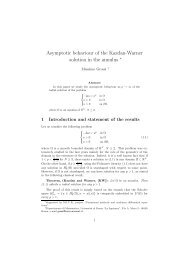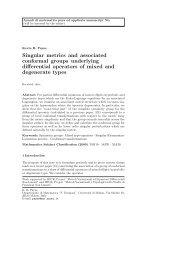Degree of Parabolic Quantum Groups - Dipartimento di Matematica ...
Degree of Parabolic Quantum Groups - Dipartimento di Matematica ...
Degree of Parabolic Quantum Groups - Dipartimento di Matematica ...
You also want an ePaper? Increase the reach of your titles
YUMPU automatically turns print PDFs into web optimized ePapers that Google loves.
5. <strong>Quantum</strong> universal enveloping algebras for parabolic Lie algebras 62<br />
iterated construction <strong>of</strong> twisted Laurent polynomial. The resulting algebra<br />
will be called T . We now claim<br />
Sǫ = T<br />
Note that, by construction T ⊂ Sǫ, so we only have to prove that Sǫ ⊂ T .<br />
Now note that<br />
E k1 · · · EkN<br />
β1 βN Ks1 1 · · · Ksn n F hN · · · Fh1 ∈ T<br />
βN β1<br />
for every (k1, . . .,kN), (h1, . . .,hN) ∈ (Z + ) N and (s1, . . .,sn) ∈ Z n . Then<br />
by proposition 5.4.6 we have Sǫ ⊂ T .<br />
The second part is obtained by using standard technique <strong>of</strong> quasi polynomial<br />
algebra. Denote by Sǫ the quasi polynomial algebra associated to Sǫ.<br />
It easy to see that Sǫ ∼ = Gr Uǫ.<br />
We finish this section with some remarks on the center <strong>of</strong> Ut ǫ. Recall that<br />
Ut ǫ is isomorphic to Uǫ for every t ∈ C∗ , hence Zt ǫ is isomorphic to Z1 ǫ = Zǫ.<br />
For t = 0, we define C0 the subalgebra <strong>of</strong> Sǫ generated by El β , Fl β for β ∈ R+<br />
and K ±l<br />
j for j = 1, . . .,n and let Cǫ be the center <strong>of</strong> Sǫ. Let Z0[t] the trivial<br />
deformation <strong>of</strong> Z0<br />
Lemma 5.4.9. (i) ρ : Z0[t] → U t ǫ defined in the obvious way is an injective<br />
homomorphism <strong>of</strong> algebra.<br />
(ii) U t ǫ is a free Z0[t] module with base the set <strong>of</strong> monomials<br />
E k1 · · ·EkN β1 βN Ks1 1 · · ·Ksn n F hN h1 · · ·F βN β1<br />
for which 0 ≤ ki, sj, hi < l, for i = 1, . . .,N and j = 1, . . .,n.<br />
Pro<strong>of</strong>. (i) follows by definitions <strong>of</strong> Z0[t]. (ii) follows from the P.B.W theorem.<br />
Lemma 5.4.10. Z0[t]/(t) ∼ = C0 and Z0[t]/(t − 1) ∼ = Z0.<br />
Pro<strong>of</strong>. Follows from the definitions <strong>of</strong> Z0[t], C0 and Z0<br />
Proposition 5.4.11. Uǫ and Sǫ are isomorphic has Z0 modules.<br />
Pro<strong>of</strong>. Follows from the previous lemma.<br />
We can now study the general case.<br />
5.4.2 general case<br />
Definition 5.4.12. Let Ut ǫ(p) be the subalgebra <strong>of</strong> Ut ǫ generated by Eβ1, i<br />
Fβj and K±1 s for i = 1, . . .,h, j = 1, . . .,N and s = 1, . . .,n.








